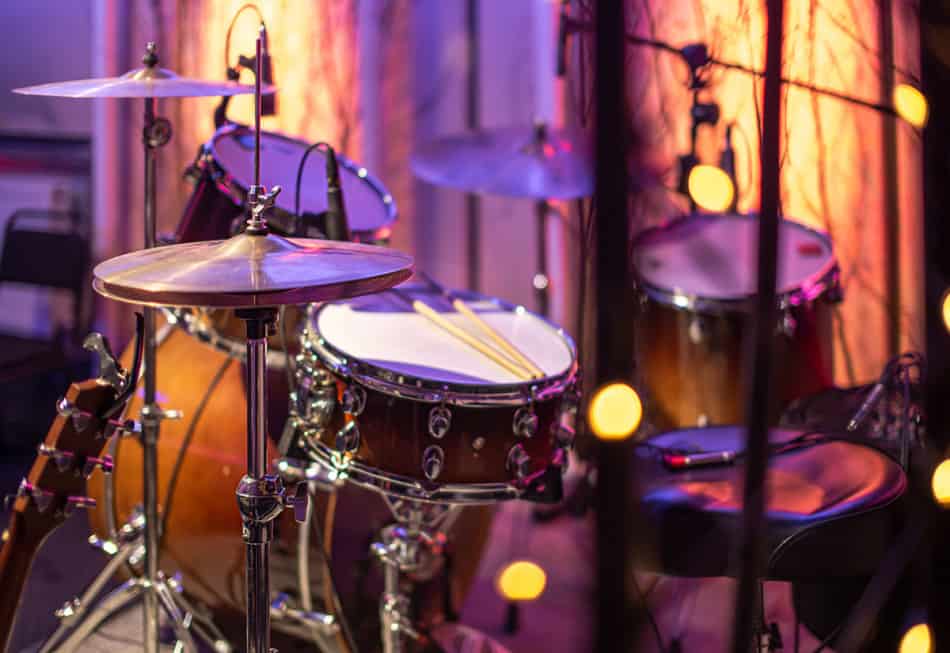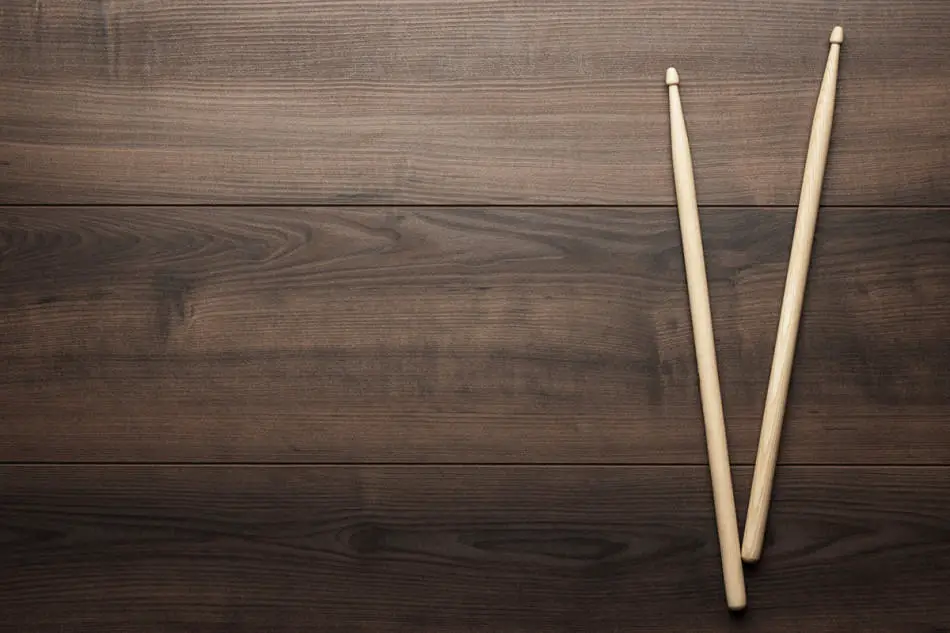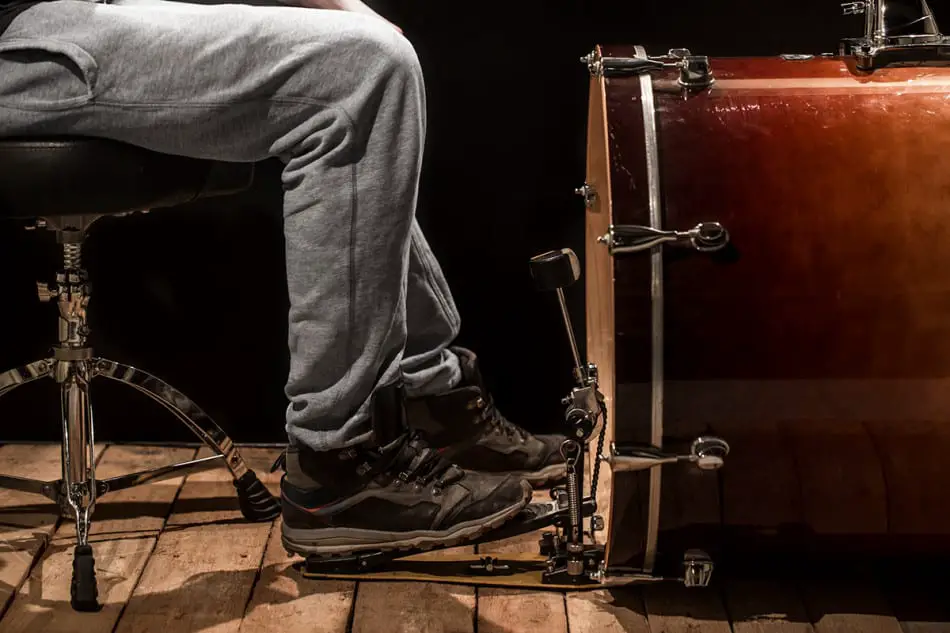Do you want to learn to play the drums, but you aren’t sure about taking lessons? Maybe you don’t want to spend the money on lessons from a professional, or maybe there aren’t any teachers in your area. Don’t worry – this guide will help you learn to play the drums without private lessons.
Here are 5 essential steps on how to teach yourself to play drums:
- Get a drum set.
- Stock up on other percussion must-haves.
- Practice rudiments.
- Practice different beats and techniques.
- Learn percussion notation.
- Establish a consistent practice routine.
Thanks to YouTube and other online resources, you should have no problem finding expert advice on playing the drums. With practice and patience, you’ll be drumming along to your favorite songs before you know it!
1. Get a Drum Set
There are hundreds of kinds of drums in the world. But when you think about “playing the drums,” what you’re probably imagining is a drum kit or drum set.
Drum sets typically consist of five drums and three cymbals. The drums are the bass drum, snare, floor tom, and two different sizes of tomtoms. The cymbals are the high-hat, ride cymbal, and crash cymbal. It takes time and practice, but you can learn to play all eight of these percussion instruments together.
There are two types of drum sets you need to consider before you make a purchase: acoustic and electronic.
Acoustic drum sets are what you’re used to seeing at concerts. However, some people find these are too noisy to play at home, so they opt for electronic drum sets.
Electronic drum sets have plastic or rubber drum heads that respond to pressure. When you hit one of these drum heads, the drum set sends a sound to an amp or headset. If you practice the drums while wearing headphones, your family and neighbors will barely hear it.
Let’s look at the pros and cons of both types of drum sets for beginners.
Acoustic
Acoustic drum sets are vibrant, dynamic, and responsive. You can create various sounds depending on the way you hit the drums and the tools you use to strike them. Playing the drums is a very physical activity, and the kinds of sounds you can make with a drum set are almost limitless.

However, acoustic drums have the potential to be very loud. You might disturb your neighbors or wake your family members when you’re trying to practice. Unless you have a soundproofed area for your drum set, you’ll be very limited about when you can practice.
Drum sets vary in price, but most beginner-level acoustic drum sets are less expensive than their electronic counterparts. You should expect to spend at least $300 on a drumset–anything less expensive is either poor quality or made for children.
For an affordable adult drum set, check out Best Choice Products 5-Piece Drum Set (available on Amazon.com). The versatile style makes it perfect for most people, and the durable build reduces the risk of you needing to replace your set anytime soon.
If you’d like a higher quality drum set, consider the Pearl Roadshow Drum Set (available on Amazon.com). This drum set has everything you’ll need to get started learning to play drums, and the hardwood drum shell makes it easier to tune the instrument.
Electronic
If you live in an apartment or have neighbors who might complain about the noise from an acoustic drum set, consider an electronic one.

Think about the time of day that you’ll be practicing drums. Do you have small children who take naps during that time? Do you only have free time late at night when the rest of your home is asleep? An electronic drum set could be the smarter choice for you.
Another advantage to choosing an electronic drum set is that some of them have play-along songs programmed in them. These tracks can help beginner drummers get used to playing with a group and make practicing fun.
Electronic drum sets are typically more expensive than beginner-level acoustic sets. They also feel different from an acoustic drum set, so you may have trouble adjusting if and when you try playing acoustic drums.
I recommend the Alesis Electric Drum Set (available on Amazon.com). It has 350 curated sounds, a built-in metronome, and dozens of play-along tracks. It has thousands of positive reviews, and it’s a fraction of the price of other high-quality electronic drum sets sold at a reasonable price.
2. Stock Up on Other Percussion Must-Haves
There’s more to playing the drums than just a drum set. You need several other pieces of equipment before you can learn to play drums, including drumsticks, a metronome, and somewhere to sit while you play. Once you have all of this gear along with your drum set, you’ll be ready to start learning to play drums.
Drumsticks
Your drum set may come with drumsticks already. If it doesn’t, you’ll need to purchase some. Plus, it can’t hurt to have an extra pair or two. Drumsticks are often lightweight and can break after prolonged use, so it’s helpful to have extras on hand.

That’s why I recommend this three-pack of AIEX 3 Pair Drum Sticks (available on Amazon.com). For an affordable price, you’ll get three pairs of maple drumsticks and a bag to store them in.
Drummers often use more than just sticks, too. They use different tools to make a variety of sounds, like brushes or bundles of sticks. This Weile Drum Sticks Set (available on Amazon.com) includes two pairs of drumsticks, a set of drum brush sticks, and a pair of wire brushes. If you’re using an acoustic drum set and want to play jazz or folk, consider buying brushes in addition to sticks.
Practice Pad
Practice pads are rubber pads shaped and sized roughly like the head of a snare drum. You can use a practice pad to practice some percussion basics quietly. If you’re using an acoustic drum set, a practice pad is essential for practicing without disturbing those around you.
Some people lay practice pads on top of their drums on an acoustic drum set. Others lay the pad on a flat surface or their lap. With the pad in place, you can practice drumming on the rubber surface while making barely any noise.
The KIBAGA Double Sided Drum Pad (available on Amazon.com) is a sturdy, long-lasting practice pad that absorbs sound and stays in place.
Throne
Drum sets are pretty low to the ground, and they require a special stool for you to sit on to reach all the drums and cymbals. This stool is called a throne, and they vary greatly in price and quality.

New drummers on a budget can make do with the ChromaCast Universal Drum and Keyboard Throne (available on Amazon.com). It can support up to 250 pounds (113.40 kg), has non-stick rubber feet, and doesn’t need to be assembled when it reaches you.
If you can afford a nicer throne, consider the ROWELL Drum Throne (available on Amazon.com). It has a comfortable motorcycle-style seat and no-slip feet. It can support up to 350 pounds (158.76 kg) and has an adjustable height.
Metronome
A metronome is essential for every musician. Drummers especially need a metronome to help them practice rhythms and stay on tempo.
One of the most popular metronomes for drummers is the BOSS Portable Metronome (available on Amazon.com). It’s durable and reliable and also has several rhythm patterns programmed to help you practice.
You can find metronomes online for free, as well. You can visit Metronome Online on a web browser or use any number of free metronome apps on your phone or tablet.
3. Practice Rudiments
While most musicians practice scales, long tones, and chord progressions, the basics of practicing drums are exercises called “rudiments.” Rudiments help you practice different rhythms, patterns, and techniques that are the building blocks of most percussion pieces.
Watch this YouTube video about the basics of drum stick technique to get comfortable holding your drumsticks:
After watching the video, set up your practice pad and get ready to play.
Watch this YouTube video by Daily Drum Lesson about all 40 rudiments and the techniques:
You can follow along on your practice pad or drum set. Rudiments will help you perfect your drum strokes, rolls, flams, and sense of rhythm in both hands.
Learning your rudiments isn’t everything. According to Stephen Clark, also called “the Nonglamorous Drummer,” you should “STOP Practicing Rudiments!”
He asks drummers to reexamine the ways they hold their drumsticks before they practice rudiments. He shows up-close, slow-motion shots of a drumstick in action so you can perfect your grip and improve your drumming. If you want to know more, watch this YouTube video:
Practicing your rudiments will give you the techniques you need to play all sorts of beats on the drumset. It may be tempting to only practice songs or “fun” beats, but rudiments will make you a better musician in the long run.
4. Practice Different Beats and Techniques
As you get more comfortable with your rudiments, it’s time to practice using different parts of your drumset. It takes time and patience to play all eight parts of the drumset together, so don’t get discouraged if you have trouble at first.
The YouTube channel Drumeo has a series of videos about learning to play a drum set. Here are some key Drumeo videos:
This YouTube video walks you through a simple beat that uses the snare, hi-hat cymbal, and bass drum:
When you’re ready to play the beat a little faster, you can start drumming along to songs on the radio. Chances are, you’ve heard a song that uses this simple, catchy beat.
This YouTube video covers five genres of music:
The instructor teaches you beats for funk, blues, jazz, country, and bossa nova. With a little practice, you can play along to songs in all five genres.
Lastly, this YouTube video is an introduction to “drum fills,” a transition from one part of a song to another that differs from the normal drum beat:
Fills are usually no more than one measure long and typically end with a cymbal crash.
With practice, you’ll get comfortable enough with different beats and fills that you can mix and match the ones you like best. Experiment with different sounds, rhythms, tempos, and volumes. Before long, you can start composing your own drum parts to play along with your favorite songs.
5. Learn Percussion Notation
Some drummers only play “by ear,” meaning they don’t read music. But reading sheet music is a useful skill that will make it much easier for you to learn new pieces later on.
Percussion notation is slightly different from regular sheet music. Even if you already know how to read music, you might have a bit of trouble picking up percussion notation. That’s because the notes on the staff in percussion notation refer to different drums in the drumset, not different pitches.
Here’s a YouTube Video a video about drum notation that you can reference:
You don’t have to know anything about reading music to follow along with his video. It’s a fantastic introduction to drum notation, regardless of your musical background.
You can also consider purchasing a book for more information about music theory, such as Patrick Wilson Alfred’s Teach Yourself to Play Drums (available on Amazon.com). It covers percussion notation, beats and fills for different genres, and all the basic rhythms you can expect to encounter. It contains all the lessons you need to become a drummer.
6. Establish a Consistent Practice Routine
The key to learning any instrument is practice, and that includes the drums. Try to dedicate 30 to 60 minutes a day to practicing if you can. If that’s too daunting, try 20 to 30 minutes five days a week. The important part is to be consistent with your practice. You’ll see better results if you practice just ten minutes every day than if you cram all your practice into a two-hour session once a week.
Here are some basic guidelines to follow when practicing:
- Start with rudiments. Use rudiments as a warm-up before you dive into beats, fills, and other exercises.
- Practice a beat, fill, or solo that’s giving you trouble. It doesn’t do you any good to only practice the beats that you’re good at. Try a difficult beat with your metronome on. Slow the tempo down until you can play it correctly, then speed up in small increments.
- Practice something fun. Play an easy rock beat that you enjoy or experiment with a drum solo. Maybe you can play drums along to your favorite song. End your practice by having fun and playing something that leaves you feeling good about yourself as a musician.
You might want to keep a journal logging your practice. A journal can help you track your progress, such as which rudiments and exercises you’ve been playing and at what tempos. Once you get comfortable with a tempo, you should increase it at your next practice session.
After a month of consistent practice, you’ll be surprised by how much you’ve improved. Look back at your early journal entries and see how far you’ve come.
Final Thoughts
Playing the drums is a fun hobby that will challenge you mentally and physically. Learning any instrument can help strengthen your brain, and you’ll also develop a new appreciation for the music you listen to.
Learning the drums takes a lot of patience. Still, it’s possible to do without private lessons, no matter your age or musical background. It’s never too late to pick up a new skill like drumming.






